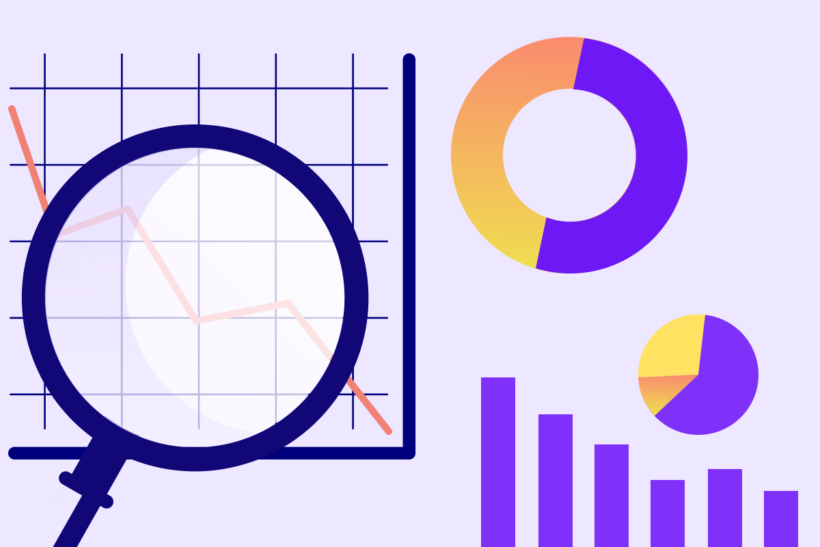
Income Statement Template for Visualizing Complex Financial Data
Learn more ->
Your sales projections directly impact revenue targets, and from there, every business decision happens like dominos; use dynamic projection templates to improve your revenue outcomes.


When I was first starting out in my career, we didn’t have the same tools that are available today. Every sales forecast was done in an offline file, emails were sent and lost between functional teams, forecasting methods were widely varied. Now, with SaaS sales tools, sophisticated forecasting solutions, and AI-powered insights, those challenges are a thing of the past. As the revenue team, we get to focus on gathering insights and bringing recommendations to the business instead of putting out fires…it’s incredible.
Content created by: Max Beauroyre, Chief of Staff at Abacum
When it comes to succeeding as a business, making enough sales revenue is foundational. Without customers to buy your products, you won’t bring in enough funds to cover business expenses, continue operations, and invest back into your organization. Because of the critical functionality of the sales team and its purpose, FP&A needs to deliver accurate sales projections on a regular basis.
For years, many organizations utilized Excel templates for sales forecasting, but these templates are often riddled with errors, contain complex calculations that need to be manually adjusted, and are not sophisticated enough to account for all the variables that should be considered in a sales forecast template. Instead of sticking to the old-fashioned way of managing sales projections, sales teams and FP&A teams should work together within a tool that is simple enough to understand yet intricate enough to factor in all the items needed for accurate forecasting.
With the right tools and powerful sales projection templates, businesses will get more visibility into their sales pipeline, be able to mitigate revenue challenges before they impact the business, and invest in the right resources where they are needed most. The sales forecast template we’ll showcase in this article is easy to set up, ensuring it adds value quickly. Once it’s in place, you can customize the template to your specific business needs.
Small businesses and mid-market companies may not have the same level of complexities in their business structure as massive public enterprises, but that doesn’t mean that they should forfeit any level of detail in their sales projection template.
The sales projection process considers historical sales, market trends, and other factors to estimate future sales. If a company has a good understanding of the sales revenue that will be coming in, it opens the doors to make many other business decisions.
Forecasting monthly sales, quarterly sales, and even annual sales is a process that happens in every single business – or should be happening at least.
Just think about it – you’re not going to start investing in a new product line if your existing product line isn’t expected to bring in enough money to cover the cost of goods sold. In this case, your FP&A team will see a red flag, work to adjust business priorities, and cover costs in one arena before branching out.
As Finance and FP&A teams continue to move toward the center of every organization, it is vital to form lasting and functional partnerships with key functions and business partners; the sales function is a top-tier priority. Without a working collaboration, sales and FP&A are heavily limited on how close they’ll get to reaching functional goals. Although the FP&A team isn’t the one that’s responsible for making the actual sales, its role in the sales forecasting process should not be underestimated.
When it’s time to update a sales forecast, FP&A will work closely with sales operations to achieve an accurate forecast outcome. Although the finance team members won’t have the same line of sight into the sales themselves, they should be well informed regarding large, upcoming deals, the timeline of critical contracts, and the sales targets for each sales representative. This information, when paired with sales history and other financial data, can be used to refine upcoming forecasts and achieve higher levels of accuracy.
All that to say, the sales forecasting process requires complete collaboration between the FP&A team and the sales team. The FP&A team might own the final forecast numbers, but the sales team is who has to deliver those numbers.
If your organization has ever considered cross-functional training, the intersection between the sales team and the FP&A team is a great place to start. Bring the sales team into the world of FP&A to understand all of the components that go into sales process, then, on the flip side, let the FP&A team observe how deals are made, what factors go into pipeline planning, and how sales quotas are determined.
Sales projections directly inform revenue projections; in fact, the forecasting processes for these two line items are often one-in-the-same. As forecasting tools and capabilities have gotten more advanced, the starting point for sales forecasting has progressed as well. Today, all sales goals should consider the following metrics:
Depending on the structure of your organization, you may factor in other variables when calculating a monthly sales forecast, but the above items are a great place to start. These variables also provide context around the importance of sales teams and FP&A partners teaming up together to create an accurate sales forecast.
Taking the time to get your sales forecast right is a worthwhile endeavor. Once you have a forecast that has a certain level of accuracy, you can anticipate many different business events, understand customer behavior at a deeper level, and plan for the future more effectively.
With a well-organized sales projection template, your organization will begin to see major improvements in the following areas:
When it comes to your sales pipeline, managing how many contracts or deals are in the works, when you expect to close them, and how much revenue they should bring in all falls under pipeline management. As businesses grow and get more complex, pipeline management becomes more complex, too.
For example, if you sell medical devices and one product is a battery replacement while another is the medical device itself, each of those items will have different runways, logistics requirements, and revenue expectations. The variability in your pipeline requires a sophisticated pipeline management process that can be made easier with the right tools, such as a sales projection template.
When you make a sale, that money goes directly into your revenue total for that sales cycle. Based on the number of units sold, your actual revenue will fluctuate. As your revenue goes up, you can decide to reinvest extra funds or grow your business. On the flip side, if your revenue is dropping and your profit margin starts to tighten, you may need to implement cost-cutting measures.
Only with the right revenue visibility can you make those types of decisions in a timely manner. If you know that you’re going to close 5 deals in the month of August, then in September, you can plan how to invest that money back into your business. With an accurate sales forecast, your revenue visibility will be as clear as possible, allowing you to run your business in a proactive manner instead of a reactive one.
Business marketing was in the background for many years, but in recent decades, it has become central to every strategic conversation and business development plan across industries. Many organizations invest big dollar amounts into marketing, and as those amounts grew, the importance of understanding the impact of those funds grew with them.
With a sales projection template and a strong handle on marketing campaigns, the sales team, marketing team, and FP&A team can understand and analyze the effectiveness of certain campaigns before deciding whether to continue with those campaigns or go back to the drawing board. If $10,000 is spent on a specific marketing initiative, but the sales funnel in relation to that campaign only brings in $2,000, then it probably won’t be a campaign that is done in the future.
Business growth requires that the sales team can keep up with demand, operate in a lean yet effective way, and adjust as the tides of operations change. With the best sales forecast possible, hiring managers and sales leaders can anticipate resource gaps, open positions, and new roles that are driven by growth, ensuring that the right people are in the right roles at the right time.
Headcount planning for a sales team is nuanced, but it’s one of the most critical functions of any business. Do you need new sales representatives in a region of major expansion? Is a new business unit in need of a bit more sales support? All of those questions can be answered by closely monitoring fluctuations in sales projections.
When it comes to sales-related headcount planning, it can be easy to get caught basing all of the planning on the growth rate of future sales, but don’t be afraid to supplement data-driven evidence with anecdotal evidence from your sales managers and sales representatives. Is everyone feeling supported? Is anyone stretched too thin? These are critical perspectives at the starting point of any good resourcing plan.
Like many things in life and business, there is more than one forecasting method when it comes to sales. Your organization may have a unique model that factors in specific variables, or you might take a simplified, general approach when just starting out as a small business.
As you perfect your method of monitoring sales performance and sales projections, here are some do’s and don’ts to think about:
| DO | DON’T |
| Factor in historical sales data | Go so high-level that decisions cannot be made based on your data |
| Adjust for seasonality if needed | Isolate salespeople from the process |
| Collaborate across functions | Ignore early data trends or warning signs |
| Continuously improve your monthly sales forecast | Get stuck in old tools like Excel or Google Sheets |
| Utilize a SaaS solution to automate and streamline your forecasting method | Create ambitious sales projections without enough headcount to support advanced sales goals |
In its most basic form, the sales forecasting process can look quite similar between businesses. But as organizations get more complex and established, the forecasting method required will likely become more intricate. Sales leaders can find a free sales forecast template on the internet, create one from scratch, or invest in a next-generation SaaS solution or apps that do all the heavy lifting for them.
If sales leaders opt for a customized forecasting method, it is entirely possible to create a sales forecast template that is effective and organized, but it will take a bit of elbow grease to get it right. So many sales forecasts that are done with a DIY approach are over-simplified; perhaps they don’t factor in all data source systems because certain CRMs are hard to tap into or maybe their accuracy lags because by the time the reports are run to collect the data, it’s already stale information. The world of sales is fast-paced, dynamic, and nuanced; a good sales forecast should follow suit.
Starting with previous year data, you can create a basic sales forecast for the upcoming year. Simply apply an estimated YoY growth rate to past data, factor in seasonality trends and big contracts, and make modifications from there. A simple sales forecast template isn’t difficult to build, but once you start bringing in more advanced variables, it can be helpful to have a more powerful tool in your business arsenal.
Microsoft Excel has served its purpose in the business world for many, many years, and although it’s not leaving the business world anytime soon, it’s time for businesses of all sizes to update their operations, implement new technologies, and boost performance through efficiency.
At the rate that the digital landscape of doing business is changing, businesses should think of Excel as a supplemental tool that complements the advanced capabilities and automation features of a dedicated FP&A tool, like Abacum.
Abacum is a full-stack SaaS solution that merges the fundamentals of business analytics in one place. Geared toward FP&A teams, the features offered by Abacum are becoming more central to general business operations because of FP&A’s role in business today. With Abacum’s revenue forecasting capabilities, sales leaders and finance executives will get a new level of visibility into sales funnels, marketing campaigns, business performance, and financial risks.
With a range of integrations available, Abacum can connect with your critical business systems – ERPs, CRMs, and other software tools – pull together all relevant data, and build outputs that will change the way you do business. We’ve specifically curated the sales forecasting module so that it seamlessly integrates with other financial insights, making it easier for your sales leaders and senior executives to make decisions that exceed organizational goals.
Unlike Excel, which needs to be manually updated, is filled with human error, and moves incredibly slowly, Abacum’s real-time insights and automation capabilities will make your FP&A team more productive, accurate, and central to the conversation, whatever it may be.
Businesses no longer have the luxury of operating in functional silos; FP&A has to think about more than finance, and those in product sales should consider a wider horizon than simply selling widgets. Everyone must come together, build a more cohesive end-to-end process, and work toward the same overarching business goals. Up until recently, it was extremely difficult to break down functional walls, encourage organization-wide teamwork, and move in unison across departments, but with Abacum in your business ecosystem, reaching greater levels of success has never been easier.
Our tool was designed with FP&A in mind, but we didn’t stop there. We built a robust platform that solves for all the business challenges your organization may face someday. We’ve addressed complex data sources, advanced analytics, insightful visualizations, customizable forecasting options, and so much more. And yes, all that is all in one tool.
We’re ready to help you shape the future of your business. The big question now is, are you ready? If you think you’re prepared to take the next steps in becoming an industry leader, advancing business development targets, or simply creating a product you’re passionate about, Abacum is the tool you need by your side. Reach out to our team to discuss how you can get a customized sales projection template ready for your business in record time.
Sales projection software helps build monthly sales forecasts, quarterly sales projections, and even annual sales estimates. With the right software, businesses can get visibility into expected sales, upcoming sales revenue, and overall sales figures. The sales function is critical to all businesses in operation today and sales projection software helps the function, along with other business functions, get the pipeline visibility needed to be successful.
When you work with an advanced sales projection tool like Abacum, getting real-time sales data happens in just a few clicks. Within seconds, your analytical resources can complete sales projection tasks that used to take hours or days. Once you have an accurate sales projection in hand, sales managers and finance leaders can pull the necessary business levers to keep your business in the green. At the end of the day, being profitable is the focus.
As explained above, you can create basic sales projection templates in Excel. All you need to do is build a table, bring in last year’s sales data, apply a few calculations to that data, and you’ll have a sales projection in Excel. As simple as the process can be, using only Excel can be very limiting when it comes to analytical capabilities and business insights for your teams to rely on.
